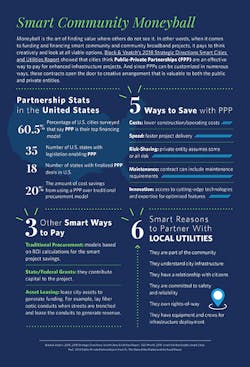Infrastructure That Connects Communities —
Not that long ago, the idea of digitally connected communities was futuristic. But today finds our physical, digital and human worlds converging at an exponential pace, disrupting nearly every industry and community across the US. With increasing pressure on state and municipal budgets, civic leaders worry about delivering essential services to their citizens and staying competitive in our ever-evolving data-driven economy.
At the same time, connected citizens are influencing the pace of innovation, pushing leaders to try new approaches and technologies. Civic leaders wishing to advance the resiliency of their infrastructure and enhance their citizens’ quality of life are digitizing their physical infrastructure. The result is an agile governance that can flex to respond quickly to changing community conditions and citizen needs. All communities — including states, municipalities, universities, medical campuses, utilities, telecommunication carriers, and mobility managers — can capture the many benefits of digital technology.
Excerpted from Black & Veatch’s newest eBook Digitally Connected Communities, this article illustrates the value of a nimble digital infrastructure and steps that community leaders can take to jump-start digitization in terms of telecommunications, smart sensors, cybersecurity and data science and analytics. Paying for digital projects is also a primary concern for communities. "Smart Community Moneyball" highlights Public-Private Partnerships as a funding mechanism.
Funding and financing are at the epicenter of configuring sustainable communities designed to evolve alongside innovation. There are several funding mechanisms, but Public-Private Partnerships support creative arrangements and provide benefits to both public and private entities.
Foundational Elements of Digital Connections
The cyber and real worlds are profoundly linked in a connected community, which is why communities are developing their foundational digital infrastructure as a first step. In fact, a recent study found that 34 percent of municipalities rated high-speed data networks as a top priority1. With robust foundational infrastructure, the community can more effectively integrate connect-sense-and-respond capabilities into its framework, changing the very nature of its systems.
These capabilities allow communities to reinvent their identity, shedding old status and stigma. Communities become redefined by their new states of functionality and create new community experiences for visitors and citizens. Even though innovation is underway, the potential of digital connections is still emerging, and citizens’ needs and desires continue to evolve. As civic leaders select projects and draw up plans, it’s important they select digital networks that can support current smart apps as well as those that evolve and converge over time.
Digital Infrastructure
It’s important to remember that digital apps have latency, bandwidth, coverage, resiliency and security requirements. As a result, communities must plan and design their infrastructure to efficiently interconnect and integrate with physical assets, like street lights, cameras, utility systems and related apps.
InvisiLight® Solution for Deploying Fiber
April 2, 2022Go to Market Faster. Speed up Network Deployment
April 2, 2022Episode 10: Fiber Optic Closure Specs Explained…
April 1, 2022Food for Thought from Our 2022 ICT Visionaries
April 1, 2022Five areas that must be addressed are described below:
1. Fiber. Fiber optic networks and deep fiber deployment enable wireless technology and ensure a community can evolve toward the future. Connected community innovation and related economic growth will be limited without deep fiber deployment2 because high-speed broadband, 5G and wireless densification cannot be fully developed. Without these capabilities, cities will be unable to leverage IoT technologies, and the digital divide in rural and underserved areas will widen.
Within the community network, fiber will also support fronthaul and backhaul from the edge of the network to the core. As communities start to deploy smart technologies, they may need to add fiber connectivity to get the desired functions and expected value. For example, an IoT security camera cannot send captured images to the cloud for real-time facial recognition processing without a robust Internet connection, via a direct fiber link or wireless small cell connection, which is also enabled by fiber.
2. Wireless. Wi-Fi, 4G LTE and 5G networks connect the mobile user and smart sensors to the community. Wi-Fi is an important amenity to citizens and can be leveraged to expand connected community apps. Because it provides last-mile connectivity, Wi-Fi helps bridge the digital divide by enabling services in low to medium income and underserved neighborhoods.
Many communities are upgrading to 4G LTE networks for faster wireless broadband speeds to support real-time voice, data, video and photo capabilities. At the same time, carriers have started to roll out 5G to establish the "next gig thing," which will allow digital apps and solutions to scale at faster rates.
The emergence of 5G may seem far away, but the expectation is 5G subscriptions will begin to lead the market as soon as 2022, while LTE growth will decline3. However, these 2 evolutions will co-exist to benefit both networks: 5G will share 4G’s extensive coverage, available spectrum and existing infrastructure, and 4G networks will leverage 5G technologies to provide better service4. While it is reasonable for industries to operate their 4G LTE system until they reach their return-on-investment, they must consider 5G when making 4G modifications to protect investments and ensure an efficient transition to 5G.
Community permitting policies are linchpins of infrastructure deployment needed to expand 4G and roll out 5G. These networks require extensive work involving rights-of-way, poles, ducts, and neighborhoods, to deploy antennae, small cells and other technologies to densify the networks. Communities that ease permitting and site access to enable technology deployment may see big dividends — a city the size of Chicago could see 90,000 new jobs and a $14 billion economic boost related to 5G technology enablement. Even a small city like Saratoga, Calif., could see 300 new jobs and a $50 million boost5. Knowing this, many communities have begun to evaluate their policies to encourage network technology deployment, and these states will be the first to see significant economic and consumer benefits6.
3. Smart Sensors. Recent LTE and 5G advances and standards have lowered the cost and energy needed to integrate many types of sensors in a community. It takes many diverse types of sensors, like fixed, human and remote sensors, connected by a network to adequately support smart management. A connected community includes several sensor nodes, so communities must understand the energy demand of sensors7, as well as data ownership and privacy, especially if the sensors collect personally identifiable information.
Sensors gather data about the community to make accurate decisions in real-time for responsive and effective management. For this reason, the location of the sensor is critical. Many communities are including spatial data with their sensors via a GIS interface to capture critical locational information. For example, a sensor that indicates flooding is only useful if the location of the flooding is also conveyed.
4. Data Science and Analytics. How a city collects, shares, and uses data is a critical consideration. Communities that build a culture of transparency will have an easier time knocking down department silos and creating open data policies, which are essential to adopt data-sharing platforms and the technologies they enable8. To keep from being overwhelmed by the vast amount of data produced by connected communities, cities should consider big data architecture and interoperability alongside telecommunications. This will help to organize data sources, ensure systems work together, sync with an analytic process and inform data monetization. It’s helpful to manage and govern data as a core component of operational systems and to prioritize data integration and processing through a network operations center.
Analytics platforms that offer dual functions can be valuable. Some platforms merge seamlessly with project management tools to collect, organize and manage applications and end users during technology deployment. Flexible platforms also perform lifecycle optimization and data-driven decision-making after deployment.
5. Cybersecurity. With multiple points of entry, a digital system is at heightened risk for cyberattack. This explains why cybersecurity is the top priority of Chief Innovation Officers across US cities, prompting 60% of cities to obtain cyberinsurance9. Fortunately, digital platforms can be designed to establish cybersecurity protections and standards across the system, which means security is embedded within apps and interconnected devices to protect data as it is transferred across connected systems.
As communications systems evolve, leaders must adopt responsible cyber-security measures that are flexible and scalable to grow with a community. A smart way to start is to conduct cyber-asset inventories. By quantifying risk, cities can prioritize and justify investments in cyberprotection and establish protections and protocols to protect community and citizen information.
Like this Article?
Subscribe to ISE magazine and start receiving your FREE monthly copy today!
Only the Beginning
While still in the early stages of breakthrough communications networks and digital infrastructure, some communities that have already deployed digital technologies are seeing innovation change their communities for the better. Through good planning and partnerships, leaders will weave technology into the social fabric of their communities to vastly improve services and systems, create a stronger bond with the citizens and amplify quality of life.
To download the full Digitally Connected Communities eBook, visit https://pages.bv.com/DigitallyConnectedCommunitieseBook.html?utm_source=ise%20magazine&utm_medium=article&utm_campaign=cc%20ebook18&utm_content=cc%20ebook18here.
Sources
1. Black & Veatch. 2018. 2017–18 Strategic Directions: Smart City / Utility Survey Results Report.
2. Deloitte. 2017. Communications Infrastructure Upgrade. The Need for Deep Fiber.
3. 5G Americas. 2018. Wireless Technology Evolution. Transition from 4G to 5G.
4. RCR Wireless. 2018. The Convergence of 4G and 5G Drives Network Evolution.
5. Accenture. 2017. How 5G Can Help Municipalities Become Vibrant Smart Cities.
6. The Lost Economy and The American Consumer Institute Center for Citizen Research. 2017. The Economic and Consumer Benefits of 5G if State and Local Governments Streamline Costly Red Tape.
7. Vjesnik, Tehnicki. 2018. Integrated Sensor Systems for Smart Cities. Technical Gazette. Jan/Feb, Vol. 25 Issue
8. Yesner, Ruthbea. 2018. Data as a Smart City Asset: The Importance of Data Sharing for Cities and Their Solution Partners. IDC.
9. Government Technology. 2017. Acting Locally: Trends from 2017 Digital Cities Survey. Infographic.










